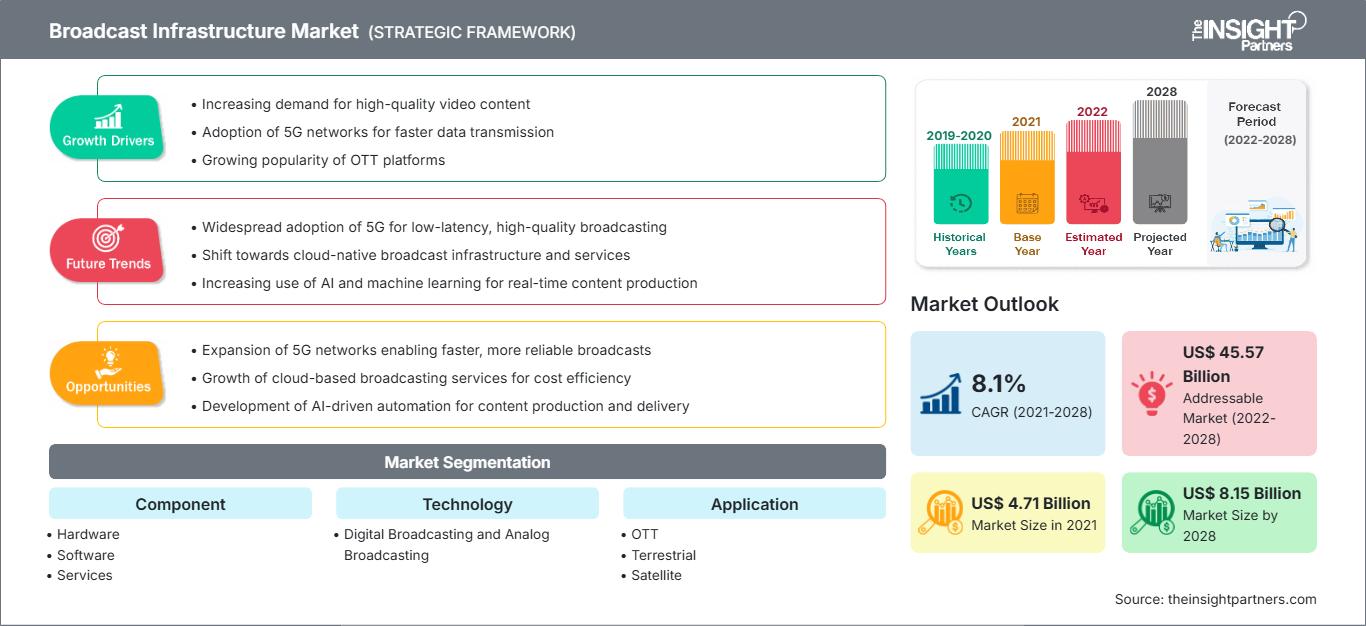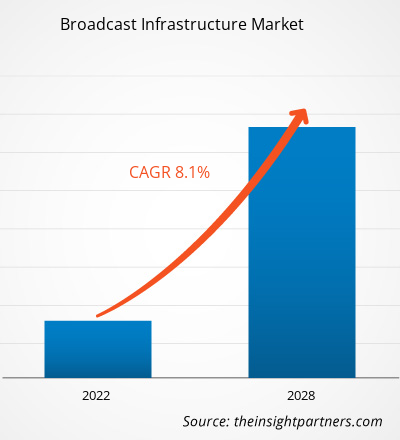[Informe de investigación] El mercado de infraestructura de transmisión se valoró en US$ 4.713,7 millones en 2021 y se proyecta que alcance los US$ 8.145,7 millones para 2028; se espera que crezca a una CAGR del 8,1% de 2021 a 2028.
El cambio de paradigma en la industria de la radiodifusión, de la tecnología analógica a la digital, ha introducido una infraestructura de transmisión avanzada y relativamente compleja. La industria de la radiodifusión está experimentando una demanda significativa de nuevas tecnologías, como la televisión por protocolo de internet (IPTV), la televisión web, la televisión de alta definición (HDTV) y el pago por visión. Se espera que la demanda de experiencias de video enriquecidas abra el camino a las emisoras de todo el mundo, especialmente en Asia. Otro factor clave que impulsa el mercado de la infraestructura de transmisión son las plataformas integradas, compuestas por servidores, decodificadores y sistemas de protección de contenido de video, junto con las herramientas, el middleware y la facturación adecuados, que permiten la prestación de diversos servicios de televisión en diversos formatos, como video a la carta, streaming y televisión en diferido, basados en una combinación de redes IP subyacentes y sistemas de acceso óptico o DSL. Actualmente, los proveedores están migrando de infraestructura basada en hardware a infraestructura basada en software debido al alto costo de la infraestructura de hardware para la radiodifusión, los altos costos de mantenimiento y las frecuentes actualizaciones de hardware. La industria de la radiodifusión ha estado experimentando innovaciones revolucionarias con desarrollos tecnológicos para brindar una mejor experiencia a los usuarios y crear una oportunidad para los proveedores de infraestructura de radiodifusión.
Personalice este informe según sus necesidades
Obtendrá personalización en cualquier informe, sin cargo, incluidas partes de este informe o análisis a nivel de país, paquete de datos de Excel, así como también grandes ofertas y descuentos para empresas emergentes y universidades.
Mercado de infraestructura de transmisión: perspectivas estratégicas

- Obtenga las principales tendencias clave del mercado de este informe.Esta muestra GRATUITA incluirá análisis de datos, desde tendencias del mercado hasta estimaciones y pronósticos.
Impacto de la pandemia de COVID-19 en el mercado de infraestructura de transmisión
Durante la pandemia de COVID-19, un gran número de personas teletrabajan, pasan más tiempo en línea y se jactan de la transición a lo digital. Esta demanda de recursos digitales está sobrecargando aún más los sistemas de varias organizaciones de software y plataformas, obstaculizando su capacidad para ofrecer servicios con fiabilidad y calidad. Sin embargo, el brote de COVID-19 ha afectado negativamente a quienes se dedican a la entrega de contenido de video a los usuarios finales, debido al cierre de empresas y la escasez de mano de obra. La crisis de la COVID-19 también ha alterado drásticamente las operaciones en toda la cadena de valor, desde las redes de proveedores hasta la experiencia de entrega al cliente, debido a los confinamientos, las prohibiciones de viaje y las interrupciones en la cadena de suministro.
Perspectivas del mercado: mercado de infraestructura de transmisión
Creciente adopción de nuevas tecnologías de transmisión
Con la continua mejora de la digitalización y el aumento de la renta disponible, el mercado está experimentando una alta tasa de adopción de IPTV y HDTV. Se espera que la demanda de experiencias de vídeo enriquecidas abra el camino a las emisoras de todo el mundo, especialmente en Asia. La proliferación de la banda ancha está aumentando en la región APAC, gracias a la oferta de contenidos bajo demanda. Además, las plataformas OTT (over-the-top) basadas en suscripción, como Netflix, están ganando terreno en Asia. Se prevé que el aumento del gasto público en infraestructura basada en la nube, soluciones y servicios gestionados basados en la nube, y redes híbridas impulse el crecimiento del mercado de infraestructura de radiodifusión. La creciente preocupación por la seguridad y el mantenimiento de la confianza de los clientes animarán a las emisoras a adoptar nuevos modelos de distribución. Es probable que todos los avances y desarrollos tengan un impacto positivo en el crecimiento del mercado durante el período de pronóstico.
Información basada en componentes
Según sus componentes, el mercado de infraestructura de transmisión se segmenta en hardware, software y servicios. El segmento de software tuvo la mayor participación de mercado en 2020.
Perspectivas regionales del mercado de infraestructura de transmisión
Los analistas de The Insight Partners han explicado detalladamente las tendencias regionales y los factores que influyen en el mercado de infraestructura de radiodifusión durante el período de pronóstico. Esta sección también analiza los segmentos y la geografía del mercado de infraestructura de radiodifusión en América del Norte, Europa, Asia Pacífico, Oriente Medio y África, y América del Sur y Central.
Alcance del informe del mercado de infraestructura de transmisión
| Atributo del informe | Detalles |
|---|---|
| Tamaño del mercado en 2021 | US$ 4.71 mil millones |
| Tamaño del mercado en 2028 | US$ 8.15 mil millones |
| CAGR global (2021-2028) | 8,1% |
| Datos históricos | 2019-2020 |
| Período de pronóstico | 2022-2028 |
| Segmentos cubiertos | Por componente
|
| Regiones y países cubiertos | América del norte
|
| Líderes del mercado y perfiles de empresas clave |
|
Densidad de actores del mercado de infraestructura de transmisión: comprensión de su impacto en la dinámica empresarial
El mercado de infraestructura de radiodifusión está creciendo rápidamente, impulsado por la creciente demanda de los usuarios finales debido a factores como la evolución de las preferencias de los consumidores, los avances tecnológicos y un mayor conocimiento de los beneficios del producto. A medida que aumenta la demanda, las empresas amplían su oferta, innovan para satisfacer las necesidades de los consumidores y aprovechan las tendencias emergentes, lo que impulsa aún más el crecimiento del mercado.

- Obtenga una descripción general de los principales actores clave del mercado de infraestructura de transmisión
Los actores que operan en el mercado de infraestructura de transmisión se centran principalmente en el desarrollo de productos avanzados y eficientes.
- En junio de 2021, EVS, el proveedor líder de tecnología de video en vivo para transmisiones y producciones de nuevos medios, anunció su asociación con Gravity Media para suministrar el sistema de revisión multicámara Xeebra como tecnología central para la nueva solución integrada de comunicaciones y adjudicación de video de la compañía.
- En junio de 2021, Ross Video anunció la adquisición de Primestream, empresa de soluciones de flujo de trabajo para activos multimedia. Estas soluciones son utilizadas por clientes de diversos sectores del mercado, como el empresarial, los medios digitales, los deportes y la radiodifusión. Sus soluciones están diseñadas para resolver los desafíos creativos, comerciales y tecnológicos, únicos y cada vez más complejos, de cada mercado. Con esta adquisición, Ross buscará integrar su solución de gestión de activos multimedia Streamline con los productos de Primestream a lo largo del tiempo para crear una plataforma de gestión de activos gráficos y de producción totalmente convergente.
El mercado de infraestructura de transmisión se ha segmentado de la siguiente manera:
Mercado de infraestructura de transmisión: por componente
- Hardware
- Software
- Servicios
Mercado de infraestructura de transmisión: por tecnología
- Transmisión digital
- Radiodifusión analógica
Mercado de infraestructura de transmisión: por aplicación
- OTT
- Terrestre
- Satélite
- Televisión por protocolo de internet
- Otros
Mercado de infraestructura de transmisión por geografía
- América del norte
- A NOSOTROS
- Canadá
- México
- Europa
- Alemania
- Francia
- Italia
- Reino Unido
- Rusia
- Resto de Europa
- Asia Pacífico (APAC)
- Australia
- Porcelana
- India
- Japón
- Corea del Sur
- Resto de APAC
- Oriente Medio y África (MEA)
- Arabia Saudita
- Emiratos Árabes Unidos
- Sudáfrica
- Resto de MEA
- América del Sur (SAM)
- Brasil
- Argentina
- Resto de SAM
Mercado de infraestructura de transmisión: perfiles de empresas
- Cisco Systems, Inc.
- Tecnología de transmisión de Clyde
- CS Computer Systems Ltd.
- Dacast Inc.
- Equipos de transmisión EVS SA
- Valle de la hierba
- Kaltura
- Nevión
- Ross Video Ltd
- Zixi
- Análisis histórico (2 años), año base, pronóstico (7 años) con CAGR
- Análisis PEST y FODA
- Tamaño del mercado, valor/volumen: global, regional y nacional
- Industria y panorama competitivo
- Conjunto de datos de Excel
Informes recientes
Informes relacionados
Testimonios
Razón para comprar
- Toma de decisiones informada
- Comprensión de la dinámica del mercado
- Análisis competitivo
- Información sobre clientes
- Pronósticos del mercado
- Mitigación de riesgos
- Planificación estratégica
- Justificación de la inversión
- Identificación de mercados emergentes
- Mejora de las estrategias de marketing
- Impulso de la eficiencia operativa
- Alineación con las tendencias regulatorias




















 Obtenga una muestra gratuita para - Mercado de infraestructura de radiodifusión
Obtenga una muestra gratuita para - Mercado de infraestructura de radiodifusión